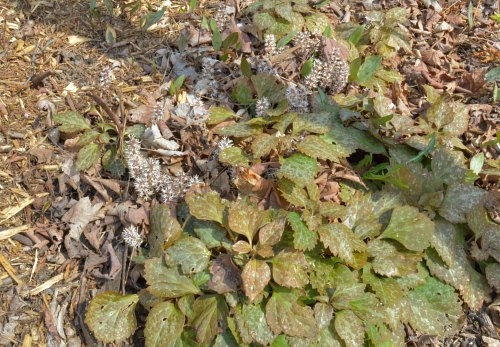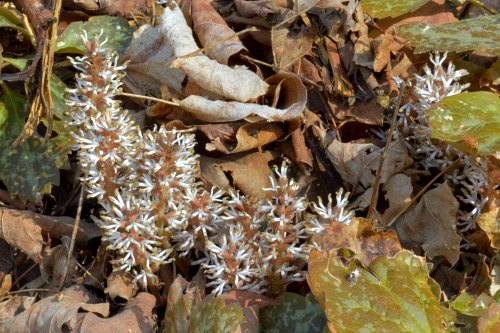Plant of the Month for March, 2017

(pak-ih-SAN-druh pro-KUM-benz)
General Information:
It is difficult to find plants for dry shade but Pachysandra procumbens will be quite happy in such conditions, at least in cooler climates. In warm areas you might need to provide more moisture.

Pachysandra procumbens:photo by Robert Pavlis
If you are thinking to yourself that you know Pachysandra and that this is an invasive Asian species that should not be planted, you would be wrong. You are thinking of Pachysandra terminalis which is very popular as a ground cover because it covers everything. Pachysandra procumbens is quite different. It is a North American native, which will slowly cover the ground. Besides being better behaved, it also flowers nicely in early spring. This is a great woodland plant and should be grown much more.
It goes by the common names Alleghany spurge and mountain spurge referencing its native habitats. It can grow in full sun in cooler climates, but does much better in part shade or even heavy shade. It spreads slowly forming a tight cover that easily keeps out the weeds.
Alleghany spurge is an evergreen in zone 5 and warmer, but in cold climates the leaves do look ratty in spring. You can remove them before it flowers, but I never bother. New spring leaves will quickly cover the old ones. In my garden this is a no maintenance plant.

Pachysandraprocumbens:photo by Robert Pavlis
The color of the leaves depend very much on the amount of light it gets and the season. Too much produces light green leaves. In heavy shade the leaves are a much darker blue-green. In spring the leaves still show some silver mottling from the previous year. As summer progresses the leaves lose the silver color and become solid green. In fall the leaves turn a reddish color and the silver returns.
Life Cycle: perennial
Height: 20cm (8 in)
Bloom Time: spring
Natural Range: Southeastern United States and Texas
Habitat: rich soil with a limestone substrate
Synonyms: none
Cultivation:
Light: part to full shade
Soil: adaptable
Water: drought tolerant in colder regions
USDA Hardiness Zone: 4 - 9
Propagation: seed, cuttings, division (seed is not used much)
Seedex availability (ORG&HPS annual Seed Exchange): rarely
